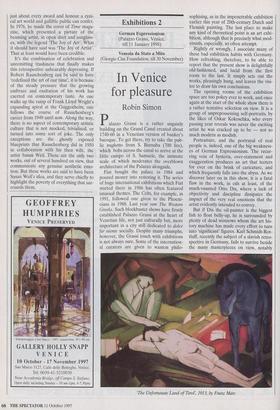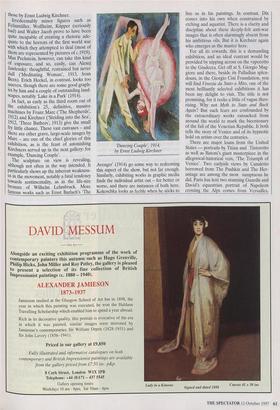Exhibitions 2
German Expressionism (Palazzo Grassi, Venice, till 11 January 1998) Venezia da Stato a Mito (Giorgio Cini Foundation, till 30 November)
In Venice for pleasure
Robin Simon
Palazzo Grassi is a rather ungainly building on the Grand Canal created about 1740-60 in a Venetian version of banker's baroque. To get there, try to take the pub- lic traghetto from S. Barnaba (700 lire), which bobs across the canal to arrive at the little campo of S. Samuele, the intimate scale of which moderates the overblown architecture of the Palazzo alongside.
Fiat bought the palace in 1984 and poured money into restoring it. The series of huge international exhibitions which Fiat started there in 1986 has often featured unusual themes. The Celts, for example, in 1991, followed one given to the Phoeni- cians in 1988. Last year saw The Western Greeks. Such blockbuster shows have firmly established Palazzo Grassi at the heart of Venetian life, not just culturally but, more important in a city still dedicated to dolce far niente socially. Despite many triumphs, however, the Grassi touch with exhibitions is not always sure. Some of the internation- al curators are given to wanton philo- sophising, as in the impenetrable exhibition earlier this year of 20th-century Dutch and Flemish painting. The last place to make any kind of theoretical point is an art exhi- bition, although that is precisely what mod- ernists, especially, so often attempt.
Rightly or wrongly, I associate many of these bad exhibition habits with Germany. How refreshing, therefore, to be able to report that the present show is delightfully old-fashioned, and lucid from the first room to the last. It simply sets out the works, pleasingly hung, and leaves the visi- tor to draw his own conclusions.
The opening rooms of the exhibition space are too pokey ever to work, and once again at the start of the whole show there is a rather tentative selection on view. It is a group of unprepossessing self-portraits, by the likes of Oskar Kokoschka, who every passing year reveals was never the exciting artist he was cracked up to be — not so much modern as modish.
Portraiture, and the portrayal of real people is, indeed, one of the big weakness- es of German Expressionism. The recur- ring vein of hysteria, over-statement and exaggeration produces an art that teeters for ever on the brink of caricature, and which frequently falls into the abyss. As we discover later on in this show, it is a fatal flaw in the work, in oils at least, of the much-vaunted Otto Dix, where a lack of objectivity and discipline dissipates the impact of the very real emotions that the artist evidently intended to convey.
But if Dix the oil-painter is the biggest fish to float belly-up, he is surrounded by plenty of dead minnows whom the art his- tory machine has made every effort to turn into 'significant' figures. Karl Schmidt-Rot- tluff, recently the subject of a slavish retro- spective in Germany, fails to survive beside the many masterpieces on view, notably 'The Unfortunate Land of Tirol', 1913, by Franz Marc those by Ernst Ludwig Kirchner. Irredeemably minor figures such as Wollheim, Kiipper (seriously bad) and Walter Jacob prove to have been quite incapable of creating a rhetoric ade- quate to the horrors of the first world war With which they attempted to deal (most of them are represented by pictures of c.1919). Max Pechstein, however, can take this kind of exposure, and so, easily, can Alexej Jawlensky: thoughtful, restrained but never dull ('Meditating Woman', 1913, from Bern). Erich Heckel, in contrast, looks too uneven, though there are some good graph- ics by him and a couple of outstanding land- scapes, notably 'Lake in a Park' (1914). In fact, as early as the third room out of the exhibition's 25, definitive, massive machines by Franz Marc (The Shepherds', 1912) and Kirchner (`Striding into the Sea', 1912, 'Three Bathers', 1913) give the small fry little chance. These vast canvases – and there are other grave, large-scale images by Marc – are one of the chief glories of this exhibition, as is the feast of astonishing Kirchners served up in the next gallery: for example, 'Dancing Couple'. The sculpture on view is revealing, although not often in the way intended. It Particularly shows up the inherent weakness- es in the movement, notably a fatal tendency towards sentimentality, as in the life-size bronzes of Wilhelm Lelunbruck. More famous works such as Ernst Barlach's 'The 'Dancing Couple', 1914, by Ernst Ludwig Kirchner Avenger' (1914) go some way to redeeming this aspect of the show, but not far enough. Similarly, exhibiting works in graphic media finds the individual artist out – for better or worse, and there are instances of both here. Kokoschka looks as feeble when he sticks to line as in his paintings. In contrast, Dix comes into his own when constrained by etching and aquatint. There is a clarity and discipline about these deeply-felt anti-war images that is often alarmingly absent from his ambitious oils. But it is Kirchner again who emerges as the master here.
For all its rewards, this is a demanding exhibition, and an ideal contrast would be provided by nipping across on the vaporetto to the Giudecca. Get off at S. Giorgio Mag- giore and there, beside its Palladian splen- dours, in the Giorgio Cini Foundation, you will find Venezia da Stato a Mito, one of the most brilliantly selected exhibitions it has been my delight to visit. The title is not promising, for it reeks a little of vague theo- rising. Why not Myth to State and Back Again? But such fears are confounded by the extraordinary works ransacked from around the world to mark the bicentenary of the fall of the Venetian Republic. It both tells the story of Venice and of its hypnotic hold on artists over the centuries.
There are major loans from the United States — portraits by Titian and Tintoretto as well as Batoni's giant masterpiece in the allegorical-historical vein, 'The Triumph of Venice'. Two earlyish views by Canaletto borrowed from The Pushkin and The Her- mitage are among the most sumptuous he did. Paris has lent two stunning Guardis and David's equestrian portrait of Napoleon crossing the Alps comes from Versailles. This was an historically acute choice, but I confess that catching sight of the little brute made me feel decidedly uncomfortable.
The exhibition continues with a whole series of superb Boningtons from all over the place; perfect Turners; and a major Francesco Hayez subject-picture. A view of the Grand Canal by Umberto Boccioni of 1907 is so intense that you regret he ever found out about Futurism.
The real surprise, however, and which raises this exhibition on to a different plane again, is the number and quality of works from that unsung school, American 19th- century painting, the last thing I expected to see anywhere in Italy. The setting is deli- ciously cool and gloomy, and in it shine more brightly jewels by William Merritt Chase, Thomas Moran, John H. Twacht- man and Maurice Prendergast.
One can never have too many pictures by Sargent and he is well represented. But I admit I knew nothing of Walter Laut Palmer, whose 'Morning in Venice' is a tour-de-force in an almost impossibly high key. It knocks spots off the neighbouring, deeply unattractive, Monet of a gondola. It is the show of the year for me — if only Napoleon didn't make me sick.
Robin Simon is Editor of Apollo. Next month he takes up the new post of Head of Publications and Editor of Art Quarterly at the National Art Collections Fund.




















































































 Previous page
Previous page